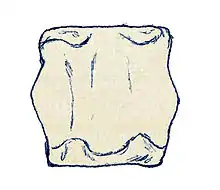Eucercosaurus
Eucercosaurus (meaning "good-tailed lizard"[1]) is the name given to a genus of ornithopod dinosaur from the Albian stage of the Early Cretaceous. It was an ornithopod discovered in the Cambridge Greensand of England and is known from 19 centra, 3 sacrals, 4 dorsals and 12 caudals, and a neural arch found near Trumpington, Cambridgeshire. [1][2] The type species, E. tanyspondylus, was described by British paleontologist Harry Seeley in 1879.[3] It is considered a dubious name, and was once considered an ankylosaur. According to a 2020 study, Eucercosaurus and Syngonosaurus were basal iguanodontians.[4]
| Eucercosaurus | |
|---|---|
 | |
| Vertebra | |
| Scientific classification | |
| Kingdom: | |
| Phylum: | |
| Class: | |
| Superorder: | |
| Order: | |
| Suborder: | |
| (unranked): | |
| Genus: | †Eucercosaurus Seeley, 1879 |
| Binomial name | |
| †Eucercosaurus tanyspondylus Seeley, 1879 | |
| Synonyms | |
| |
References
- http://www.paleofile.com/Dinosaurs/Armor/Eucercosaurus.asp
- M. K. Vickaryous, T. Maryanska, and D. B. Weishampel. 2004. Ankylosauria. In D. B. Weishampel, P. Dodson, and H. Osmolska (eds.), The Dinosauria (second edition). University of California Press, Berkeley 363-392
- Seeley, H.G. (1879). "On the Dinosauria of the Cambridge Greensand". Quarterly Journal of the Geological Society. 35 (1–4): 591–636. doi:10.1144/GSL.JGS.1879.035.01-04.42. ISSN 0370-291X. S2CID 129277596.
- Barrett, Paul M.; Bonsor, Joseph A. (2020). "A revision of the non-avian dinosaurs Eucercosaurus tanyspondylus and Syngonosaurus macrocercus from the Cambridge Greensand, UK". Cretaceous Research: 104638. doi:10.1016/j.cretres.2020.104638.
This article is issued from Wikipedia. The text is licensed under Creative Commons - Attribution - Sharealike. Additional terms may apply for the media files.